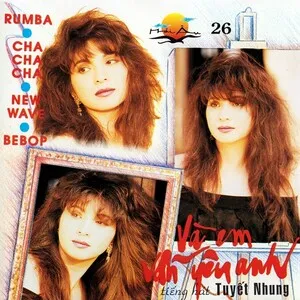Vietnamese new wave is a Vietnamese take on the global new wave, Italo‑disco, and synth‑pop movements of the 1980s and early 1990s. It blends four‑on‑the‑floor drum machines, arpeggiated synth bass, lush pads, and chorus‑drenched guitars with Vietnamese melodic sensibilities and lyrics.
Initially thriving in dance clubs and diaspora community shows, the style popularized Vietnamese‑language covers and adaptations of European and American new wave/eurobeat hits, alongside original songs crafted with the same neon‑lit, high‑energy aesthetic. Its sound is simultaneously club‑ready and sentimental, emphasizing minor‑key verses, big sing‑along hooks, and glossy, reverb‑soaked production.
Vietnamese new wave emerged in the late 1980s as Vietnam reopened culturally after Đổi Mới and as overseas Vietnamese communities built vibrant music circuits in the United States and France. Young Vietnamese listeners gravitated toward imported European new wave, Italo‑disco, hi‑NRG, and synth‑pop, fostering a club culture that favored brisk four‑on‑the‑floor beats, bright synthesizers, and romantic, cinematic hooks.
In Little Saigon (Orange County), Paris, and other diaspora hubs, show producers and labels staged elaborate dance showcases and video programs featuring Vietnamese‑language covers and original tracks crafted in the new wave/eurobeat mold. Parallel scenes in Ho Chi Minh City and other urban centers adopted the same repertoire for discotheques and youth dances. The result was a cross‑Pacific ecosystem of performers, dancers, and arrangers specializing in glossy, high‑energy Vietnamese new wave.
The style fused Linn/808‑style drum programming, sequenced bass arpeggios, DX7 and Juno‑type synth timbres, and chorus‑soaked rhythm guitar. Song forms typically paired melancholic, minor‑key verses with soaring, major‑tinged choruses. Reverb‑heavy vocals and bilingual hooks (Vietnamese with occasional English refrains) cemented its cosmopolitan feel.
Even as mainstream Vietnamese pop diversified in the 2000s, the genre’s DNA persisted in V‑pop’s dance‑pop wing and in club forms such as Vinahouse. Periodic retro revivals, medleys, and DJ edits keep Vietnamese new wave staples in circulation, while its synth‑forward palette and sentimental dancefloor ethos continue to inform contemporary Vietnamese production.
Aim for 112–126 BPM with a steady four‑on‑the‑floor kick and syncopated off‑beat hi‑hats or claps. Use classic drum‑machine palettes (LinnDrum, 808/909) with gated or plate reverbs to evoke period sheen.
Write in minor keys for verses and pivot to brighter relative‑major or modal mixture hooks in the chorus. Favor diatonic progressions (i–VI–VII–i or i–IV–V) with occasional borrowed chords for lift. Melodies should be lyrical and singable, leaving space for counter‑melodies from synths or guitar.
Combine an arpeggiated or sequenced synth‑bass (Juno‑106, SH‑101 style) with warm pads (JX/D50), bell or EP/FM plucks (DX7), and chorus‑drenched clean guitar for rhythmic propulsion. Arrange intro–verse–pre–chorus–chorus–verse–bridge–double‑chorus with at least one breakdown that strips to drums, bass, and a lead line before the final lift.
Use intimate, reverb‑rich lead vocals with doubled or harmonized choruses. Lyrics often balance romantic longing and nightlife imagery, mixing Vietnamese narration with occasional English catchphrases for hook emphasis. Call‑and‑response or gang‑shouted tags can heighten the chorus energy.
Layer multiple synths for width, pan rhythmic guitars subtly left/right, and glue the mix with bus compression and a touch of tape/saturation. Sidechain pads lightly to the kick for dancefloor movement, and employ short, bright reverbs plus longer plates on key hits to create that neon, cinematic space.








